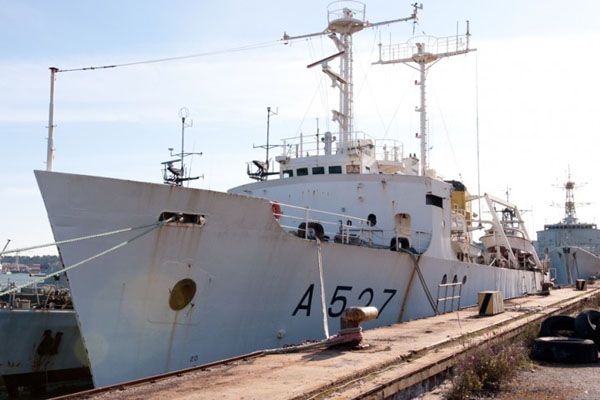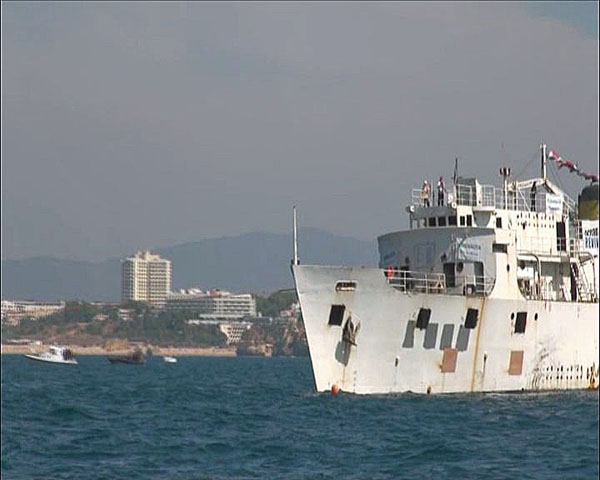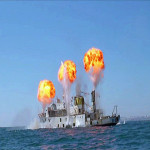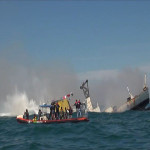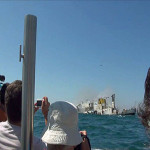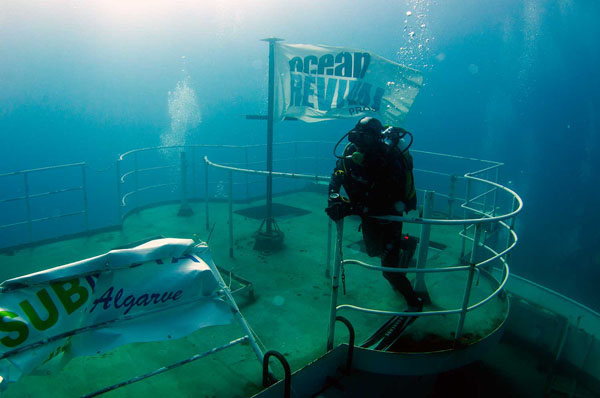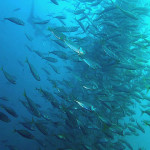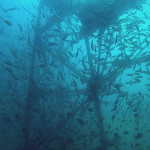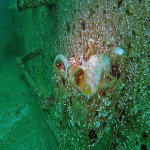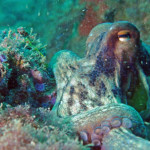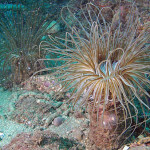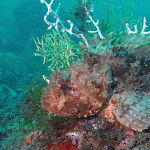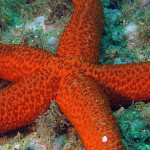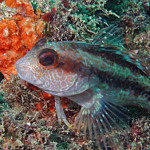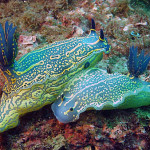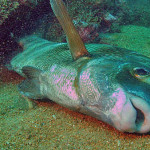Marine Life & Conservation
Ocean Revival: A New Marine Reserve in the Algarve
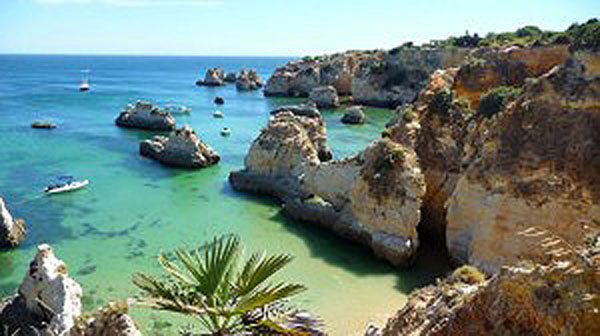
Photos by Jeff Goodman and Kam Arya
As all divers know, ship wrecks of all types make great habitats for all kinds of marine life. Unfortunately they are often not protected against fishing and pressures of careless diving. Now there are four new wrecks in the Algarve, Portugal, which have been put on the sea bed to act as sanctuary for marine life and are to be protected by the Portuguese Fisheries Department and the Navy.
I was a guest of Luís Sá Couto, the project leader of Ocean Revival and owner of the SUBNAUTA Diving Centre. I had been invited to see the last ship of the four become a future reef. The Hydrographic ship Ex-NRP Almeida de Carvalho was to be submerged into 30 metres of water where her top decks would only be 15 metres below the surface.
The evening before the event, Luis gave me a tour of the ship while she was still in dock. By the time I saw her she had been fully prepared for sinking. All toxic and dangerous materials had been removed. Doorways opened and passageways all made accessible for the safety of future divers. Whole sections of flooring were removed for easy access to the lower decks and hold areas.
Luis then checked with the demolition crew where the on-board cameras were to be mounted. They would capture the entire sinking from the ship itself. Known to be reliable and produce high quality images, sixteen Gopro were mounted in various parts of the ship on deck and inside the hull. While each camera was being set up we were able to monitor their output on Luis’s iPhone via a Gopro app. Fantastic! (Scubaverse will be showing the actual Gopro videos soon.)
The next day we were in a rib dive boat heading out to the site of the sinking. As we got near the Almeida de Carvalho it was obvious the people on board were making the final preparations for the explosions which would send her to the sea bed. The ship’s hull was filled with tons of concrete so that she would sink in an upright position and not roll over on the way down. This would also give stability to the wreck and minimize any movement during winter storms.
The tugs made their final adjustments to the ships position and the anchors were dropped. Cameras were clicking constantly as the anticipation rose and we were told by the Pilot boat to now head away to the safe perimeter. There would be a five minute warning over the radio to let us know the sequence for detonation of the explosives was about to start.
I looked over to the mainland where I knew Luis was holding a press conference in one of the hotels. It was there that Luis was able to verify from the Minister of the State of the Sea, the Fisheries Department and the Navy, that these four Ocean Revival ships, with a limited area around them, would be a marine reserve and so protected by legislation and enforcement. This was indeed great news for marine conservation and the future.
Then it all happened. Three fireballs rose from the decking. A series of explosions cracked through the air as debris from the ship flew into the sky. All went quiet as the ship sat still in a small pall of smoke. Gradually the bow started to sink. It was very slow, but then it gathered momentum and within a minute the entire ship was swallowed by the blue water, leaving only a tell-tale footprint of froth and air bubbles. Almeida de Carvalho had gone.
A group of Navy divers now had to go down and make sure all the explosives had detonated. Two hours later we were able to dive the ship ourselves. With trapped air bubbles still rising to the surface we made our way down the shot line tied off near the bow. It’s quite surreal seeing a ship on the sea bed that was only a few hours ago sitting up at the surface. The shiny metal looked out of place and there were no fish to ease the desolate feel of the wreck. But that would change in time.
The three previous wrecks, only a few months old, have already become home to marine wildlife. Fish shoal around the rigging and railings while an octopus finds sanctuary in an old vent. Trigger fish patrol the forward decks; smaller fish browse the fast growing algae.
The wrecks will not take long to become mini reefs and as such should sustain a good diversity of life. Before having to return to the UK I had a chance for a dive on one of the local reefs in about 15 metres of water just off a nearby headland. The water temperature was a pleasant 20C and the visibility was an adequate six metres. At first it seemed very similar to diving on a reef at home in Cornwall, but without the kelp. Gradually I started to realise there was an interesting mix of species, both of temperate and warmer waters, Conger eels living next to Morays eels.
On this dive there were no great shoals of fish to see but the small species where abundant.
It was a great dive and only slightly marred for me by the body of a dead fish on the sea bed with wounds from a spear gun. It no doubt suffered before dying but will now go to feeding a host of other marine animals.
The Algarve is not high on the destinations of many divers but after my visit I certainly look forward to going back again. In my next article I shall be interviewing Luís Sá Couto about diving in the Algarve and the high standard of facilities divers can expect.
Blogs
Invitation from The Ocean Cleanup for San Francisco port call

6 years ago, The Ocean Cleanup set sail for the Great Pacific Garbage Patch with one goal: to develop the technology to be able to relegate the patch to the history books. On 6 September 2024, The Ocean Cleanup fleet returns to San Francisco bringing with it System 03 to announce the next phase of the cleanup of the Great Pacific Garbage Patch and to offer you a chance to view our cleanup system up-close and personal.
We look forward to seeing you there.
To confirm your presence, please RSVP to press@theoceancleanup.com
PROGRAM
Join The Ocean Cleanup as our two iconic ships and the extraction System 03 return to San Francisco, 6 years and over 100 extractions after we set sail, to create and validate the technology needed to rid the oceans of plastic.
Our founder and CEO, Boyan Slat, will announce the next steps for the cleanup of the Great Pacific Garbage Patch. Giving you a chance to view our cleanup system and the plastic extracted.
Hear important news on what’s next in the mission of The Ocean Cleanup as it seeks to make its mission of ridding the world’s oceans of plastic an achievable and realistic goal.
Interviews and vessel tours are available on request.
PRACTICALITIES
Date: September 6, 2024
Press conference: 12 pm (noon)
Location: The Exploratorium (Google Maps)
Pier 15 (Embarcadero at Green Street), San Francisco, CA
Parking: Visit The Exploratorium’s website for details.
RSVP: press@theoceancleanup.com
Video & photo material from several viewing spots around the bay
We look forward to seeing you there!
ABOUT THE OCEAN CLEANUP
The Ocean Cleanup is an international non-profit that develops and scales technologies to rid the world’s oceans of plastic. They aim to achieve this goal through a dual strategy: intercepting in rivers to stop the flow and cleaning up what has already accumulated in the ocean. For the latter, The Ocean Cleanup develops and deploys large-scale systems to efficiently concentrate the plastic for periodic removal. This plastic is tracked and traced to certify claims of origin when recycling it into new products. To curb the tide via rivers, The Ocean Cleanup has developed Interceptor™ Solutions to halt and extract riverine plastic before it reaches the ocean. As of June 2024, the non-profit has collected over 12 million kilograms (26.4 million pounds) of plastic from aquatic ecosystems around the world. Founded in 2013 by Boyan Slat, The Ocean Cleanup now employs a broadly multi-disciplined team of approximately 140. The foundation is headquartered in Rotterdam, the Netherlands, and opened its first regional office in Kuala Lumpur, Malaysia, in 2023.
Find out more about The Ocean Cleanup at www.theoceancleanup.com.
Marine Life & Conservation
SHARK MONTH ARRIVES AT ROYAL WILLIAM YARD, PLYMOUTH

A shark has been spotted approaching Royal William Yard in Plymouth, much to the surprise of swimmers, paddleboarders and onlookers.
With its distinctive dorsal fin cutting through the water, the sizeable shark swam along the coastline, before turning to head inland towards Firestone Arch at Royal William Yard. The appearance drew a crowd, who were captivated for more than an hour by the unusual sight – and it was all caught on video.
The shark is one of many expected sightings at Royal William Yard over the coming weeks… because today marks the start of Shark Month!
In reality, the ‘shark’ spotted along the Plymouth shoreline was actually a custom-made model, created by the team at Royal William Yard and sailed underwater by Caroline Robertson‑Brown from the Shark Trust, who donned scuba diving gear for the occasion.
The stunt took place to launch Shark Month in style and draw attention to the work of the leading international conservation charity, which is based in Britain’s Ocean City. Spectators were reassured that the water was safe and many entered into the spirit of the performance, swimming or sailing alongside the shark.
Shark Month will take place across Royal William Yard throughout July and will feature an extravaganza of art, entertainment and advocacy for everyone to enjoy. The packed programme of events starts with an art exhibition and ends with a trip on paddleboards with shark experts – with everything from a shark quiz to a Jaws screening in between.
Paul Cox, CEO of the Shark Trust, said: “There are often assumptions and misconceptions when it comes to sharks. This was certainly the case with the shark spotted at Royal William Yard! While the British coastline is home to many species of shark, this was not one of them. However, we’re thrilled it caught people’s attention, because seeing a shark is a special and memorable moment. That is precisely why we want to celebrate these incredible creatures, highlight the need for conservation, and ask for help to safeguard their future.”
For more information about Shark Month at Royal William Yard, visit the Shark Trust Website.
Images and video: Jay Stone
-

 Blogs2 months ago
Blogs2 months agoDiving With… Nico, Ocean Earth Travels, Indonesia
-

 News1 month ago
News1 month agoMurex Bangka Announce New Oceanfront Cottages & Beachfront Dining
-

 Blogs2 months ago
Blogs2 months agoA new idea in freediving from RAID
-

 Marine Life & Conservation1 month ago
Marine Life & Conservation1 month agoIceland issue millionaire whale hunter a licence to murder 128 vulnerable fin whales
-

 Marine Life & Conservation2 months ago
Marine Life & Conservation2 months agoThe Shark Trust Great Shark Snapshot is back
-

 News3 months ago
News3 months agoCharting New Waters; NovoScuba Goes Global with the Launch of their Revolutionary Dive Training Agency!
-

 Gear News1 month ago
Gear News1 month agoNew Suunto Ocean – a dive computer and GPS sports watch in one for adventures below and above the surface
-

 Marine Life & Conservation Blogs2 months ago
Marine Life & Conservation Blogs2 months agoBook Review: Plankton


